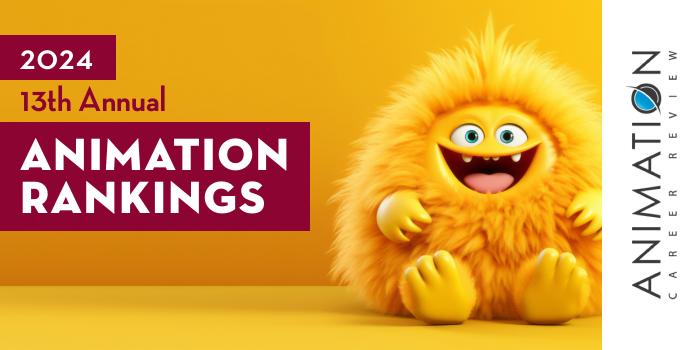
Master 3D modeling for film and video games in under 2 years with CG Spectrum. Get personalized career training online from leading 3D artists from major studios, plus career support and access to a vibrant community. Learn more.

| Ranking | School | City |
|---|---|---|
| 1 | Carnegie Mellon University | Pittsburgh |
| 2 | University of the Arts | Philadelphia |
| 3 | Drexel University | Philadelphia |
| 4 | University of Pennsylvania | Philadelphia |
| 5 | Pennsylvania Western University, Edinboro | Edinboro |
Our 2024 ranking -our thirteenth annual- of the top animation school programs in Pennsylvania. For an explanation of the ranking criteria, click here.

Carnegie Mellon University’s (CMU) is home to the Integrative Design, Arts and Technology Network (IDeATe). In collaboration with Robotics Institute (est. 1979) in the School of Computer Sciences, the IDeATe network manages 10 undergraduate minors, including Animation & Special Effects.
Consisting of a minimum of 27 units, the Animation & Special Effects minor allows students to gain experience in areas such as digital 2D and 3D animation techniques; visual effects and procedural animation; real-time animation systems; expanded and experimental animation methods; and storytelling through animation. Project-based courses for the program are led by faculty with expertise in Art and Robotics.
Course examples include Technical Character Animation; Topics in Animation: Story Development; Advanced ETB: Animation Studio; IDeATe Special Topics in Animation: Bipedal Rigging for Animation Production; and Introduction to 3D Animation Pipeline.
The IDeATe Animation & Special Effects courses are open to all students. This provides opportunities for animation minors to collaborate with students from game design, film, digital media, and more.
For students seeking a four-year undergraduate degree, the College of Fine Art (CFA) at Carnegie Mellon University has an interdisciplinary BFA in Electronic & Time-Based Media (BFA ETB) that explores areas such as animation, computational and interactive arts, game arts, and video and performance. Students in this program will take advanced courses such as Animation, Art, and Technology; Experimental Game Design; Digital Storytelling and Resistance; and Digital Storytelling and Resistance.
Graduates of the ETB and Animation & Special Effects programs at Carnegie Mellon University are prepared to pursue positions at major studios, networks, and gaming companies. Program alumni have been hired at places such as DreamWorks Animation, Electronic Arts (EA), MTV, Paramount, Blizzard Entertainment, Sony Interactive Entertainment, Walt Disney Studios, Warner Interactive, Zynga Games, and Comedy Central.
Founded on November 15, 1900 by industrialist and philanthropist Andrew Carnegie, Carnegie Mellon University opened its doors as Carnegie Technical Schools. Today, this private global research university provides more than 200 programs to approximately 16,780 students from 126 countries. In addition to the main campus in Pennsylvania, CMU has campuses in California's Silicon Valley and Doha, Qatar. Housed across seven colleges and schools, Carnegie’s academic programs are also provided in Africa, Asia, Australia, Europe, Mexico, and Portugal. Carnegie Mellon University is accredited by the Middle States Commission on Higher Education (MSCHE).

The School of Film at University of the Arts (UArts) has three paths to study animation. Options include the Animation BFA, a BFA in Film & Animation, and an Animation minor. The School of Film encourages collaboration between schools, so all students have opportunities to study design, photography, acting, and other disciplines.
The Animation BFA allows students to focus in 2D, 3D, or Stop Motion Animation. Students may also create a hybrid focus path. The Film & Animation BFA explores styles and genres across animation and filmmaking. Examples include experimental, computer-generated animation, documentary, traditional animation, stop motion, and narrative. Across programs, students have opportunities to work with professionals and faculty associated with major studios and networks such as Nickelodeon, HBO, Comedy Central, Netflix, IFC, Disney Animation Studios, and Cartoon Network.
The BFA curriculum combines hands-on teaching with internships at studios such as Augenblick, Stretch Films Inc., and Sesame Workshop; study away experiences in places such as France and South Korea; and formal critiquing sessions designed to evaluate the students’ progress and work. BFA students also have opportunities to interact with guest speakers and alumni; collaborate on projects with peers; and participate in lectures and screenings.
A major component of the Animation programs at University of the Arts is the Professional Practices requirement. During this multifaceted course, which takes place in the third year of the programs, provides the opportunity for students to post their reels to their branded portfolio websites; participate in mock interviews; design business cards, resumes, and other materials; and develop social media strategies.
The Animation programs at UArts also provide access to a 5,600-square-foot space known as the Center for Immersive Media (CIM). Within the CIM, students can explore other areas such as human-computer interaction (HCI), VR/AR, and performance motion-capture. In addition to CIM, animation students have unlimited access to computer labs and state-of-the-art animation, film, and stop-motion studios.
The Animation and Film BFA at UArts culminates with the Animation Thesis or Film Thesis completed across two courses. The culminating experience for the Animation BFA is the Animation Thesis, completed across two courses. For Animation BFA students who would like to complete an additional project, the program provides the option to complete the Client Animation Project course instead of an internship.
University of the Arts Animation graduates are prepared to pursue roles such as Character Animator, Storyboard Artist, Effects Animator, Computer Animator, Art Director, Cinematographer, Clay/Puppet Animator, Director, Motion Graphics Designer, Producer, Animatic Editor, Scientific Animator, Forensic Animator, and Background Artist.
UArts graduates have been hired local companies and studios such as Center City Film & Video, Alkemy X, and unPOP. UArts alumni also work at major companies, studios, and networks such as Sony Interactive Entertainment, HBO, Warner Bros., DreamWorks, Netflix, Cartoon Network, Google, Walt Disney Animation Studios, Nickelodeon, Google, Augenblick, Titmouse, and Bento Box Entertainment.
Founded in 1876 as part of the Philadelphia Museum of Art, University of the Arts serves approximately 1,315 students enrolled in more than 40 degree programs in fine arts, design, media arts, dance, music, theater, and crafts. More than 20 minors are available and open to all students. UArts programs are offered in the Schools of Art, Dance, Design, Film, Music, Theater Arts, and Graduate and Professional Studies. University of the Arts is accredited by the Middle States Commission on Higher Education (MSCHE).

The Antoinette Westphal College of Media Arts & Design at Drexel University (Drexel) has several paths to study animation. Options include the Animation and Visual Effects (VFX) BS; Digital Media MS; Dual Animation and Visual Effects BS/Digital Media MS; Digital Media and Virtual Production BS/ Digital Media MS; and Digital Media PhD. An eight course (24-credit) Animation and VFX minor is also available.
The curriculum for this program provides a foundation in the design, storytelling, and technological skills used by 3D animators and VFX artists in the entertainment and design worlds. Minor students also have the opportunity for customize the program through 12 credit hours of electives. Lighting & Surfacing; Scripting for Animation and VFX; Digital Character Creation; and Technical Directing are just a few elective examples. The Animation and VFX minor can be taken alone or with just about any degree program within the College of Media Arts & Design.
The Dual BS/MS programs consist of coursework and projects in animation, 3-D modeling, gaming, advanced digital design, and interactivity. The programs also explore digital media history, theory, and methods. Dual BS/MS programs require a minimum of 232 credit hours to graduate.
The Animation & VFX BS program provides instruction and hands-on training in 3D modeling, character design, scripting and storytelling, motion capture, compositing, storyboarding, and rigging. The Digital Media MS at Drexel University is a two-year program that focuses on research and media applications. Areas explored include animation, advanced digital design, gaming and digital media history, 3D modeling, and interactivity.
Students in this program will complete several independent, industry-sponsored, student-created, or faculty-approved projects. Past projects have focused on animation design, advanced animation production techniques, narrative comics, and video games, among others.
The PhD is a research-driven degree that take place in an experiential learning environment. Besides entertainment, PhD students may conduct research in business, engineering, health, education, or other areas.
Drexel University has one of the nation’s top cooperative (co-op) education programs, so students in all degree programs have the opportunity to gain valuable hands-on experience prior to graduation. During the junior year, BS students will spend six months working full-time in the industry. Dual BS/MS students will participate in three co-op experiences in the second, third, and fourth years of study.
Positions may be paid or unpaid. Past co-op positions include animation, visual effects, technical direction, and 3D work at places such as Pixar, Cartoon Network, Sony Studios, FuseFX, and MediaKraft TV.
Graduates of the Animation & VFX and Digital Media programs at Drexel University have worked on projects such as Avengers: Infinity War, The Mandalorian, Ready Player One, and How to Train Your Dragon 2. Other program alumni go on to work in research and development in the fields of virtual reality, real-time rendering solutions, and generative design.
Drexel Animation & VFX and Digital Media graduates have also been hired by major companies and studios such as Pixar, Microsoft, XBOX, DreamWorks, Disney, and NCSoft Corp.
Drexel University was established in 1891 as Drexel Institute of Art, Science, & Industry. The school serves approximately 22,345 students enrolled in more than 200 degree programs across 15 colleges and schools. Drexel University is accredited by the Middle States Commission on Higher Education (MSCHE). The school’s academic programs in art, design, and media are accredited by the National Association of Schools of Art & Design (NASAD).

University of Pennsylvania (UPenn) is home to the Stuart Weitzman School of Design, which houses a variety of animation resources for students across all programs. Students have access to computer labs with Wacom tablets, and 2D and 3D animation and compositing applications such as Maya, Matchmover, After Effects, 3ds Max, Mudbox, Premiere, Flash, TV Paint, and many others. For stop-motion animation projects, the school has sound recording and editing equipment, DSLR cameras, and lighting and grip equipment to be used with Dragonframe software. A stop-motion and multiplane studio with a dedicate capture workstation as available as well.
Stuart Weitzman School of Design also houses the undergraduate program in Fine Arts and Design (FNAR) with an interdisciplinary major in FNAR. This Art BA program combines seminar courses with studio instruction, and the visiting artist lecture series. Coursework for the program allows students to study animation, digital design, 3D modeling, and more. Course examples include Design and Digital Culture; Mixed Media Animation; Advanced 3D Modeling; Cinema Production; Hand-Drawn Computer Animation; Digital Figure Modeling; Environmental Animation; 3D Computer Modeling; and Computer Animation.
Another path to study animation at UPenn is the Digital Media Design (DMD) program. Launched in 1998, DMD is part of the School of Engineering and Applied Science (SEAS). Leading to a Bachelor’s in Engineering and Science (BSE) with a DMD major, this interdisciplinary program allows students to study animation, games, virtual reality design, computer graphics, and interactive technologies. Course examples include Computer Animation, Drawing Investigations, Interactive Computer Graphics, Advanced Rendering, and 3D Computer Modeling.
The School of Engineering and Applied Science at University of Pennsylvania also houses the Center for Human Modeling and Simulation (HMS). Within the HMS Center is a Computer Graphics and Game Technology (CGGT) Engineering MS (MSE) program.
Established in 2004, this interdisciplinary program provides opportunities to specialize in Art and Animation, Animation and Simulation Technology; Creative Design; Production Management, or Human/Computer Interfaces. Students in this program have access to equipment and resources available through the SIG Center for Computer Graphics.
Course examples for the MSE include Computer Animation; 3D Computer Modeling; Physically-Based Animation; Interactive Computer Graphics; Physically-Based Rendering; Digital Figure Modeling; and Advanced Project Animation.
Students in the UPenn CGGT MSE program will spend their first year in the Master of Computer and Information Technology (MCIT) program. Upon completion, students may pursue the CGGT degree. Because they have taken a total of 16 courses, graduates will receive two degrees: the MCIT and MSE CGGT.
Graduates of UPenn’s MSE CGGT, DMD, and MCIT, programs are prepared to pursue careers and entrepreneurship in areas such as animation, design, directing, and game programming. Program alumni are routinely hired by major companies and studios such as Pixar, Microsoft, Walt Disney Animation, Activision Blizzard, Electronic Arts (EA), DreamWorks Animation, Sony, Industrial Light & Magic (ILM), and Zynga.
University of Pennsylvania (UPenn) is one of the nation’s oldest universities. Founded in 1740 by Benjamin Franklin, the school serves approximately 28,200 students enrolled in more than 400 programs across 12 schools. University of Pennsylvania is accredited by the Middle States Commission on Higher Education (MSCHE).

The College of Arts, Humanities and Social Sciences at Pennsylvania Western University, Edinboro (PennWest Edinboro) houses a Department of Art that provides Visual Arts programs at all degree levels. Other Department features include visiting artist and speakers; dedicated studio spaces; multiple galleries with frequent exhibitions; courses taught by accomplished specialists across creative industries; and National Association of Schools of Art and Design (NASAD) accreditation.
Among the Art Department’s academic programs is a Media Arts BFA that explores Animation, Digital Filmmaking, and Photography. BFA students may specialize in Animation. The concentration explores hand-drawn and computer-generated animation, character design, storyboarding, visual development, and stop-motion. Course examples include Digital Drawing and Painting; 2D Design; Graphic Novel Art and Design; 3D Modeling and Rigging; Stop Motion and Experimental Animation; 2D Digital Animation; Digital Visual Effects; Storyboard and Character Design; 3D Dynamics and Simulations; Digital Audio-Moving Image, and Animation Pipeline.
Students will also complete Animation Portfolio Prep. During this immersive course (worth three to six credits) students will work with 3D computer modeling, animation, sound, advanced nodal surfacing, and special effects through lectures and practical demonstrations. Students will also work on a group computer animation project, a detailed modeling project, complete their digital portfolio, and give a software demonstration.
Other Animation program highlights include access to state-of-the-art facilities such as the 2D Cintiq Lab; opportunities to engage with professional animators, storyboard artists, and directors during special on-campus events; participation in regular exhibitions of peer and faculty work; travel to animation conferences and festivals in Los Angeles, New York, and Toronto; participation in the Animation Club; an internships with local, regional, and national production studios; and opportunities to tour major studios such as DreamWorks, Nickelodeon, Sony, Disney, Universal, Warner Bros, and Stoopid Buddy Stoodios.
The Media Arts BFA with an Animation concentration culminates with the Animation Production Capstone. Graduates are prepared to pursue careers across the entertainment, game design, and advertising industries, among others. Program alumni go on to become Animators, Character Designers, Visual Effects (VFX) Artists, Modelers, Storyboard Artists, and Directors.
Graduates of the PennWest Edinboro Animation program have been hired at major studios such as Disney, DreamWorks, Pixar, Blizzard Entertainment, and Nickelodeon.
Founded in 1857 as a private raining school for teachers, Pennsylvania Western University is western Pennsylvania’s second largest university. Composed of three sister institutions (Penn West Edinboro, PennWest Clarion, and PennWest California), the school serves a total of 11,305 students enrolled in hundreds of majors, minors, and graduate programs. PennWest Edinboro serves approximately 4,320 students enrolled in 100 majors and minors across 22 academic departments. Pennsylvania Western University is accredited by the Middle States Commission on Higher Education (MSCHE).